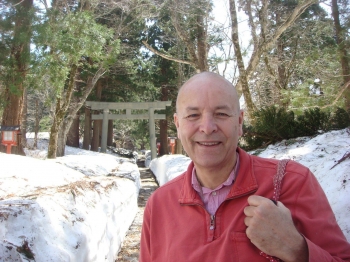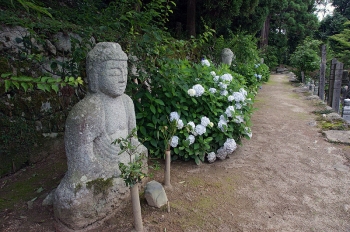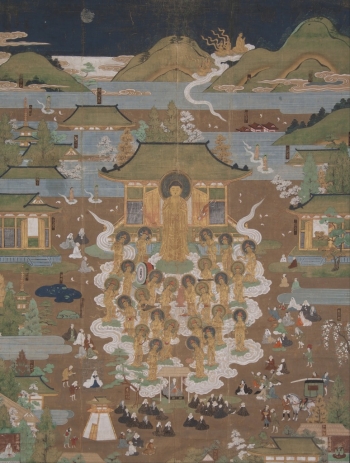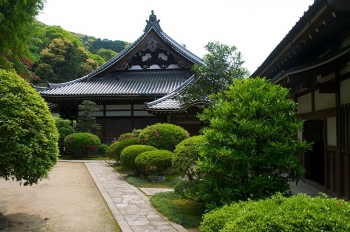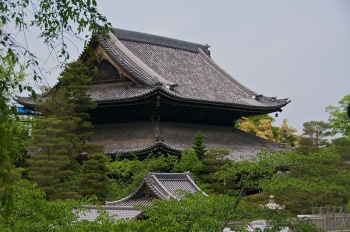Editor’s note: David Brazier is a Buddhist teacher, writer, and psychotherapist. He is President at Instituto Terapia Zen Internacional in Spain and the head of the Amida Order in the United Kingdom. An international authority on Buddhist psychology, he practices in the humanist, existential, and psychodynamic schools of psychotherapy. He has written prolifically on poetry, psychology, and culture. David’s books include (among others) Zen Therapy, The Feeling Buddha, Love and Its Disappointment: The meaning of life, therapy and art, and Not Everything is Impermanent. Visit the website of the Amida Trust here.
In this essay, David outlines how a specific tradition of Japanese Pure Land Buddhism was imported to the West. He also explores possible reasons why Pure Land as a whole has historically been less popular in the West than its Zen and Vajrayana sisters. David’s own journey may offer ideas as to why Pure Land needs to contemplate more creative ways to diffuse into Western societies.
European interest in Buddhism began in the period of colonialism during the 18th and 19th centuries. In European universities, Theravada Buddhism was presented as a relatively scientific religion, or even as “not a religion” and as the purest form of Buddhism. At that stage, Western commentators were inclined to dismiss Tibetan Buddhism as a fabric of superstition. Although the latter hurdle has been overcome, the idea that Buddhism is “not a religion” (except when there is government money available for religions, etc.) has stuck in many quarters.
In the early part of the twentieth century there was also some intellectual interest in Buddhism in America. Thinkers like the psychologist William James saw in Buddhism a fount of ancient wisdom that anticipated and went beyond many of their own modern discoveries. Thus in the West, Buddhism had a close connection with psychology from the beginning. Psychology itself was struggling to present itself as scientific for much the same reasons as Theravada Buddhism had done. To be “scientific” is a doorway to status in the West.
America, a melting pot for immigrants, saw substantial numbers of Chinese and Japanese, many of whom followed Pure Land Buddhism. During the Second World War civilian Japanese were interned in camps. On release after the war they were mostly resettled away from the West Coast, and Pure Land Buddhist temples were established in Chicago, New York and elsewhere. These, however, were primarily a means of cultural survival for the Japanese and did not take in many Caucasian members. Chinese temples were somewhat easier for white Americans to connect with, but they too primarily served an ethnic population.
In Europe, the post-war period saw an influx of Tibetan refugees, fleeing the Chinese annexation of Tibet. This diaspora led to Tibetan Buddhism becoming the best-known form of Buddhism in several European countries, including France, Spain and Italy, among others. In America, during this period, the main interest was Zen, arriving first from Japan, then Korea and finally China. Zen made lesser, though still significant headway in Europe, mostly coming via America.
By the late twentieth century, therefore, there was a well-established interest in Buddhism. This was apparent in most West European countries, and by far the greater part of this was devoted to Vajrayana, Zen and Theravada. Pure Land was and still is barely known about. Just as Tibetan Buddhism was once regarded as a superstitious aberration, so, today, many Europeans, if they know of Pure Land at all, tend to regard it as an aberrant that has somehow, misguidedly, adopted a form uncomfortably close to Christianity. This last point is significant because European Buddhists are, if not immigrants, almost all converts. They have taken up Buddhism in this generation and they have substantially done so as part of a rejection of their ancestral religion. To many, Pure Land looks too much like the religion they have left. Ideas of faith, grace, a transcendent Buddha, devotional practice, and, in the Japanese forms, a priesthood that has many similarities to the Protestant clergy, all ring warning bells.
In my own case, I started studying Buddhism when I was in my early twenties in Cambridge. I studied Theravada meditation with a Burmese teacher and Tibetan Buddhism with Chogyam Trungpa Rinpoche. Then I met a Zen master. This was Jiyu Kennett Roshi, an English woman who had learnt her Zen in Sojiji Monastery in Japan and was now returning to the West with a mission. I became her disciple for many years. Roshi, however, did not find Britain a fertile environment for her style and settled in California. I got many things from my years of study with her, including ordination as a Zen priest, an appreciation of the writings of Eihei Dogen, a profoundly experiential understanding of Soto Zen, and exposure to her implacable conviction that Buddhism is religion. In a way, she taught me not only that Buddhism is a religion, but also that it is the essence of all religion. Although she was a Zen teacher, there was a strong thread of Pure Land devotional thinking in her approach and I absorbed it.
Subsequently I studied with other teachers, Tibetan, Theravada and finally Thich Nhat Hanh. I became a member of his Tiep Hien Order and was greatly inspired by the ideas of socially engaged Buddhism that he promoted. Ideas are one thing and action is another. It proved extremely difficult to get British followers of Tiep Hien to take any serious action of a socially engaged nature. The small number of us who did try formed a distinct group and this later became the core of the Amida Trust.
At this time I was also practising as a psychotherapist. One conference that I attended took me to New York. In one of the breaks I was walking down Riverside in Manhattan and I saw a statue that was clearly Buddhist, though not a seated Buddha. It was a statue of Shinran, the populariser of Pure Land in medieval Japan. It was standing outside a Pure Land Buddhist temple. I went in and sat down at the back. A service was in progress, mostly in Japanese. At the end of the proceedings the minister announced that the congregation was presenting a petition on nuclear disarmament and he urged all to attend the presentation. I could not imagine such socially engaged activity in any of the Buddhist temples that I was familiar with in Britain, so I stayed on after the service to talk with this community.
Encounters of this kind slowly drew me into an ever-deeper interest in and connection with Pure Land. It spoke to my condition in a number of ways. I started attending Pure Land gatherings and connecting with Pure Land priests and teachers. I made visits to Japan. On one of these I found that my visit was being substantially organised by Reverend Gisho Saiko, a Jodo Shinshu priest and founder of Shinshu Counselling. He already had a long-standing interest in my work concerned with interpreting Buddhist psychology to Western audiences.
The encounter with Saiko Sensei proved crucial in my case. He wanted to receive what I had to offer, but also to transmit to me his desire to see Pure Land Buddhism and Buddhist psychology transmitted more effectively to the West. For many Japanese, the various forms of Pure Land, Jodo-shu, Shin-shu, Ji-shu, etc – represent the pinnacle of Eastern spirituality. However, most Westerners, if they think of Japanese Buddhism, think immediately and almost exclusively of Zen. In Japan, of the four largest Buddhist denominations, three are Pure Land and none are Zen.
In the meantime, our group in the UK had established a charitable trust to act as a vehicle for our work. This was called Amida Trust. The name was not originally chosen with the intention of designating the organisation as Pure Land. It was chosen because in Buddhist iconography, Amida (Amitabha Buddha) established a Pure Land or the Western Paradise and, for a group intent on propagating socially engaged Buddhism in the West, this seemed apt. However, names have power and the Amida label certainly made our group more attractive and accessible to our Japanese Pure Land friends. Some, we noticed, started to refer to it as Amida-shu.
In the early part of the twentieth century there was also some intellectual interest in Buddhism in America. Thinkers like the psychologist William James saw in Buddhism a fount of ancient wisdom that anticipated and went beyond many of their own modern discoveries. Thus in the West, Buddhism had a close connection with psychology from the beginning. Psychology itself was struggling to present itself as scientific for much the same reasons as Theravada Buddhism had done. To be “scientific” is a doorway to status in the West.
America, a melting pot for immigrants, saw substantial numbers of Chinese and Japanese, many of whom followed Pure Land Buddhism. During the Second World War civilian Japanese were interned in camps. On release after the war they were mostly resettled away from the West Coast, and Pure Land Buddhist temples were established in Chicago, New York and elsewhere. These, however, were primarily a means of cultural survival for the Japanese and did not take in many Caucasian members. Chinese temples were somewhat easier for white Americans to connect with, but they too primarily served an ethnic population.
In Europe, the post-war period saw an influx of Tibetan refugees, fleeing the Chinese annexation of Tibet. This diaspora led to Tibetan Buddhism becoming the best-known form of Buddhism in several European countries, including France, Spain and Italy, among others. In America, during this period, the main interest was Zen, arriving first from Japan, then Korea and finally China. Zen made lesser, though still significant headway in Europe, mostly coming via America.
By the late twentieth century, therefore, there was a well-established interest in Buddhism. This was apparent in most West European countries, and by far the greater part of this was devoted to Vajrayana, Zen and Theravada. Pure Land was and still is barely known about. Just as Tibetan Buddhism was once regarded as a superstitious aberration, so, today, many Europeans, if they know of Pure Land at all, tend to regard it as an aberrant that has somehow, misguidedly, adopted a form uncomfortably close to Christianity. This last point is significant because European Buddhists are, if not immigrants, almost all converts. They have taken up Buddhism in this generation and they have substantially done so as part of a rejection of their ancestral religion. To many, Pure Land looks too much like the religion they have left. Ideas of faith, grace, a transcendent Buddha, devotional practice, and, in the Japanese forms, a priesthood that has many similarities to the Protestant clergy, all ring warning bells.
In my own case, I started studying Buddhism when I was in my early twenties in Cambridge. I studied Theravada meditation with a Burmese teacher and Tibetan Buddhism with Chogyam Trungpa Rinpoche. Then I met a Zen master. This was Jiyu Kennett Roshi, an English woman who had learnt her Zen in Sojiji Monastery in Japan and was now returning to the West with a mission. I became her disciple for many years. Roshi, however, did not find Britain a fertile environment for her style and settled in California. I got many things from my years of study with her, including ordination as a Zen priest, an appreciation of the writings of Eihei Dogen, a profoundly experiential understanding of Soto Zen, and exposure to her implacable conviction that Buddhism is religion. In a way, she taught me not only that Buddhism is a religion, but also that it is the essence of all religion. Although she was a Zen teacher, there was a strong thread of Pure Land devotional thinking in her approach and I absorbed it.
Subsequently I studied with other teachers, Tibetan, Theravada and finally Thich Nhat Hanh. I became a member of his Tiep Hien Order and was greatly inspired by the ideas of socially engaged Buddhism that he promoted. Ideas are one thing and action is another. It proved extremely difficult to get British followers of Tiep Hien to take any serious action of a socially engaged nature. The small number of us who did try formed a distinct group and this later became the core of the Amida Trust.
At this time I was also practising as a psychotherapist. One conference that I attended took me to New York. In one of the breaks I was walking down Riverside in Manhattan and I saw a statue that was clearly Buddhist, though not a seated Buddha. It was a statue of Shinran, the populariser of Pure Land in medieval Japan. It was standing outside a Pure Land Buddhist temple. I went in and sat down at the back. A service was in progress, mostly in Japanese. At the end of the proceedings the minister announced that the congregation was presenting a petition on nuclear disarmament and he urged all to attend the presentation. I could not imagine such socially engaged activity in any of the Buddhist temples that I was familiar with in Britain, so I stayed on after the service to talk with this community.
Encounters of this kind slowly drew me into an ever-deeper interest in and connection with Pure Land. It spoke to my condition in a number of ways. I started attending Pure Land gatherings and connecting with Pure Land priests and teachers. I made visits to Japan. On one of these I found that my visit was being substantially organised by Reverend Gisho Saiko, a Jodo Shinshu priest and founder of Shinshu Counselling. He already had a long-standing interest in my work concerned with interpreting Buddhist psychology to Western audiences.
The encounter with Saiko Sensei proved crucial in my case. He wanted to receive what I had to offer, but also to transmit to me his desire to see Pure Land Buddhism and Buddhist psychology transmitted more effectively to the West. For many Japanese, the various forms of Pure Land, Jodo-shu, Shin-shu, Ji-shu, etc – represent the pinnacle of Eastern spirituality. However, most Westerners, if they think of Japanese Buddhism, think immediately and almost exclusively of Zen. In Japan, of the four largest Buddhist denominations, three are Pure Land and none are Zen.
In the meantime, our group in the UK had established a charitable trust to act as a vehicle for our work. This was called Amida Trust. The name was not originally chosen with the intention of designating the organisation as Pure Land. It was chosen because in Buddhist iconography, Amida (Amitabha Buddha) established a Pure Land or the Western Paradise and, for a group intent on propagating socially engaged Buddhism in the West, this seemed apt. However, names have power and the Amida label certainly made our group more attractive and accessible to our Japanese Pure Land friends. Some, we noticed, started to refer to it as Amida-shu.
Links
Friends of the Amitabha Order: http://amidatrust.ning.com
Instituto Terapia Zen Internacional: http://itzi-red.ning.com
Amida Academy: http://courses.zentherapyinternational.com
